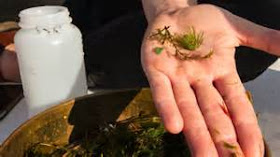
 Tiny plastic pellets called microbeads have gotten a lot of
attention as a major water pollutant, but less-discussed microplastics are
equally concerning, according to new research being done in Canada.
Tiny plastic pellets called microbeads have gotten a lot of
attention as a major water pollutant, but less-discussed microplastics are
equally concerning, according to new research being done in Canada. "In recent years, they've been detected in a growing
number of lakes and rivers worldwide. They're everywhere, and often in alarming
levels," said Anthony Ricciardi, a professor at the McGill School of the
Environment, who is working on a study about microplastics.
"In recent years, they've been detected in a growing
number of lakes and rivers worldwide. They're everywhere, and often in alarming
levels," said Anthony Ricciardi, a professor at the McGill School of the
Environment, who is working on a study about microplastics.
Microplastics are small particles of plastic less than five
millimetres in size that are often found in bodies of water near large urban
populations. Microbeads, which are used in toothpastes, makeup and body
cleansers, are one part of the broader category of microplastics.

Microbeads are "getting all the attention, but they're
only one component to this," Ricciardi said. "As time goes on, people
are going to realize the importance of the other pieces, too."
A 2014 study of the U.S. Great Lakes by the 5 Gyres
Institute found an average of 43,000 microplastic particles per square
kilometre. Near cities, the number jumped to 466,000.
The plastic particles in the Great Lakes include microbeads, but also come from other sources, such as bits of polymer that detach from clothing when it is washed,
as well as granules from industrial abrasives.
The plastic particles in the Great Lakes include microbeads, but also come from other sources, such as bits of polymer that detach from clothing when it is washed,
as well as granules from industrial abrasives.
Source: CBC...More...

No comments:
Post a Comment